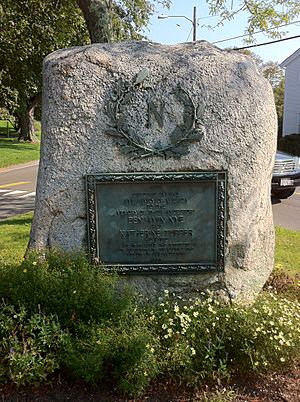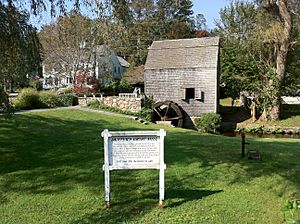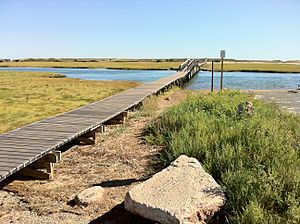Sandwich, Massachusetts facts for kids
Quick facts for kids
Sandwich, Massachusetts
|
|||
|---|---|---|---|
|
Town
|
|||
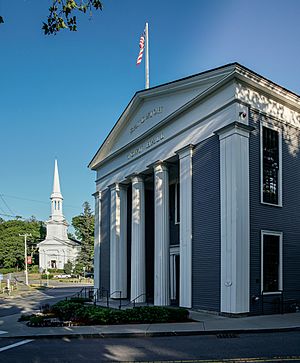
Sandwich Town Hall (1834) and Congregational Church (1848)
|
|||
|
|||
| Motto(s):
Post Tot Naufracia Portus (Latin)
"After So Many Shipwrecks, A Haven" |
|||
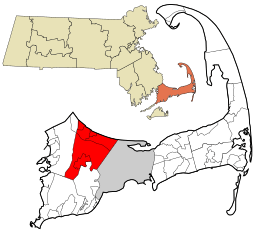
Location in Barnstable County, Massachusetts
|
|||
| Country | United States | ||
| State | Massachusetts | ||
| County | Barnstable | ||
| Settled | 1637 | ||
| Incorporated | September 3, 1639 | ||
| Government | |||
| • Type | Open town meeting | ||
| Area | |||
| • Total | 44.2 sq mi (114.5 km2) | ||
| • Land | 42.7 sq mi (110.7 km2) | ||
| • Water | 1.5 sq mi (3.8 km2) | ||
| Elevation | 20 ft (6 m) | ||
| Population
(2020)
|
|||
| • Total | 20,259 | ||
| • Density | 474/sq mi (183.0/km2) | ||
| Time zone | UTC−5 (Eastern) | ||
| • Summer (DST) | UTC−4 (Eastern) | ||
| ZIP Codes | |||
| Area codes | 508, 774 | ||
| FIPS code | 25-59735 | ||
| GNIS feature ID | 0618259 | ||
Sandwich is a historic town located on Cape Cod in Massachusetts. It is known as the oldest town on Cape Cod. The town's motto, Post tot Naufracia Portus, means "After So Many Shipwrecks, A Haven". In 2020, about 20,259 people lived in Sandwich.
Contents
History of Sandwich
Before Europeans arrived, the Wampanoag tribe lived on Cape Cod. They spoke an Eastern Algonquian language. The Wampanoag people helped the Pilgrims when they settled in Plymouth Colony in the 1620s. Today, the Mashpee Wampanoag Tribe still lives on Cape Cod. They are working to bring back their traditional Wampanoag language.
Early Settlement and Growth
In 1637, a group of settlers from Saugus, Massachusetts came to Sandwich. They had permission from the Plymouth Colony. The town was named after the seaport of Sandwich, Kent in England. Sandwich became an official town in 1639. This makes it the oldest town on Cape Cod, along with Yarmouth. In 1884, the western part of Sandwich became a new town called Bourne.
Sandwich was also one of the first places where Quakers settled. Today, it has the oldest Quaker Meeting that has been active continuously in the U.S.
Industries and Economy
In the early days, people in Sandwich mostly farmed. Fishing and trading were also important for the town. Later, small factories grew along the Scusset River. Today, most of Sandwich's economy comes from tourism.
Deming Jarves started the Boston & Sandwich Glass Factory in 1825. Sandwich was a good location because it had a shallow harbor and plenty of wood to fuel the glass furnaces. The factory was famous for making beautiful colored glass. Jarves also invented better ways to make glass molds. After the Civil War, the factory faced competition from other companies. These companies made cheaper glass, and the Sandwich factory eventually closed.
The Cape Cod Canal was built through Sandwich. Construction started in 1909, and the canal opened for boats in 1914. The Canal Generating Plant, a power plant, began operating in 1968.
Geography and Nature
Sandwich covers about 114.5 square kilometers (44.2 square miles). Most of this area is land, with about 3.8 square kilometers (1.5 square miles) being water. To the north, Sandwich borders Cape Cod Bay. It is next to Barnstable to the east, Mashpee and Falmouth to the south, and Bourne to the west. Sandwich is about 57 miles (92 km) south-southeast of Boston.
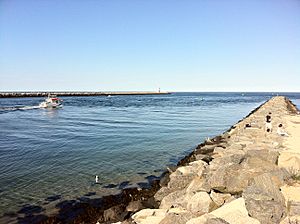
The Cape Cod Canal enters Cape Cod Bay in Sandwich. The northern part of Sandwich, including Sagamore Hill and Scusset Beach State Reservation, is separated from the rest of the town by the canal. Sandwich is also home to the Shawme-Crowell State Forest and the Massachusetts State Game Farm. The town has six beaches along Cape Cod Bay. Like other parts of Cape Cod, Sandwich has many small ponds and hills. Most of its trees are pine or oak. Old Harbor Creek, a large inlet with smaller creeks, once provided a safe place for ships.
Climate and Environment
Sandwich has a humid continental climate. This means it has warm summers and gets rain all year. Winters are cold, with an average of about 30 inches (76 cm) of snow each year. February is usually the snowiest month.
The natural plant life in Sandwich is mostly Northeastern Oak/Pine forests. You can also find some Southern Mixed Forest types.
Transportation in Sandwich
U.S. Route 6, also known as the Mid-Cape Highway, runs through the northern part of Sandwich. It is a four-lane highway with three exits in town. Massachusetts Route 6A is another important road that runs north of Route 6. It is the main local road in Sandwich. Massachusetts Route 130 starts near the intersection of Routes 6 and 6A. It goes along the eastern side of Otis Air National Guard Base towards Mashpee.
Freight trains serve Sandwich through the Massachusetts Coastal Railroad. The Cape Cod Central Railroad offers fun tourist train rides from Hyannis to Buzzards Bay. These trains stop at the Sandwich station. For longer trips, the nearest Amtrak train stations are in Boston and Providence.
The closest airports for private and regional flights are in Barnstable. For national and international flights, the nearest major airport is Logan International Airport in Boston.
Population and People
In 2000, Sandwich had 20,136 people living there. There were 7,335 households, and 5,515 of these were families. The population density was about 468 people per square mile (183 people per square kilometer).
About 28.4% of the people in town were under 18 years old. The average age was 40 years. For every 100 females, there were about 94.5 males.
The average income for a household in Sandwich was $61,250. For families, the average income was $66,553. About 3.1% of the population lived below the poverty line.
Town Government
Sandwich uses an open town meeting style of government. This means that citizens can attend meetings and vote on town matters. The town is managed day-to-day by a board of selectmen, which has five members. They appoint a town manager to run things. George H. "Bud" Dunham has been the town manager for over 30 years.
The town has its own police department and a fire department with three stations. There are three post offices in Sandwich: East Sandwich, Sandwich, and Forestdale. The Sandwich Public Library is in the town center. It is part of several library networks, allowing people to borrow books from many places. Sandwich also has a public access TV station, Sandwich Community TV, which records and shares all government meetings online.
Education in Sandwich
Sandwich has its own public school system.
- Forestdale School serves students from Pre-Kindergarten to 2nd grade.
- Oak Ridge School is for students in grades 3 through 6.
- The STEM Academy is for grades 7 and 8. It is located within the high school building.
- Sandwich High School, located in East Sandwich, serves students from grades 7 through 12. The school's sports teams are called the Blue Knights, and their colors are navy blue, Columbia blue, and white.
High school students in Sandwich can also choose to attend the Upper Cape Cod Regional Technical High School in Bourne. This school offers vocational training. Another option is Sturgis Charter Public School in Hyannis. Some students also attend private schools in nearby towns or even outside of Cape Cod.
Fun Places to Visit
Sandwich has many interesting places to visit:
- Heritage Museums and Gardens: A large area with gardens, museums, and a carousel.
- Wing Fort House: A very old house with a lot of history.
- Sandwich Glass Museum: Here you can learn about the town's famous glass-making history.
- Thornton Burgess Museum: Dedicated to the famous children's author and conservationist.
- Hoxie House: Known as the oldest house on Cape Cod.
- Dexter Grist Mill: The oldest mill on Cape Cod.
- Sandwich Friends (Quaker) Meetinghouse: The oldest Quaker meetinghouse in North America.
- Shawme Lake: A beautiful lake in the town.
Many of these attractions are found in the Town Hall Square Historic District and Jarvesville Historic District. A large part of Otis Air National Guard Base is also located in Sandwich.
The Sandwich boardwalk is a popular spot in downtown Sandwich. It leads to the Town Beach on Cape Cod Bay. It is 1,350 feet long and crosses Creek Mill and the marsh. The boardwalk was first built in 1875. In 1991, Hurricane Bob almost completely destroyed it. It was rebuilt in 1992, with people buying personalized planks to help pay for it. The boardwalk was damaged again by blizzards in March 2018 but was rebuilt and reopened in June 2018.
A winter storm in late 2021 and early 2022 caused more damage to the boardwalk. The town began rebuilding a new version of the boardwalk in late 2023. This new boardwalk is expected to be open to the public in the summer of 2024.
Famous People from Sandwich
- Thornton Burgess (1874–1965): A famous conservationist and author of children's books like the Old Mother West Wind series.
- Duff Goldman (born 1974): A well-known pastry chef and TV personality. He graduated from Sandwich High School in 1993.
- Edmund Freeman: One of the town's founders and a Deputy Governor of Plymouth Colony.
See also
 In Spanish: Sandwich (Massachusetts) para niños
In Spanish: Sandwich (Massachusetts) para niños




